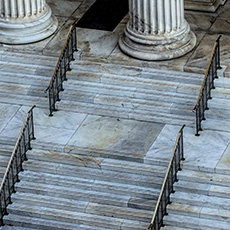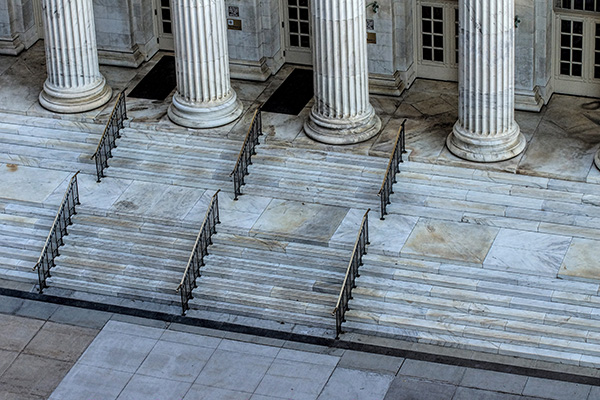
Life changed – in a good way – for millions nationwide in 1990, when the Americans with Disabilities Act (ADA) was passed.
A moment seared into history happened when more than 60 disabled activists (including an 8-year-old with cerebral palsy) put aside their wheelchairs and crutches to crawl up the 83 steps to the Capitol Building. Nothing else could have demonstrated accessibility barriers more clearly, and the ADA was signed into law four months later.
Of course, putting the law into practice wasn’t easy, and accessibility, even after a quarter of a century and a major update in 2010, still isn’t perfect. That said, the impact of the ADA and how it governs a facility’s functionality is all-encompassing and continues to evolve.
So, Who Has to Comply with What Standards?
Accessibility in federal buildings is governed by the Architectural Barriers Act, which was enacted by Congress in 1968. All buildings and facilities owned or leased by the federal government must comply with the accessibility standard.
The US General Services Administration sets out exactly who that is: “Any person involved in the design, construction, alteration and leasing of federally owned or leased facilities,” and that includes building managers.
When it comes to the ADA, on the other hand, “the spirit of the law is voluntary compliance,” notes Curbed editor Patrick Sisson. “The law works on an ‘after-the-facts’ system known as injunctive relief; developers can build whatever they want, but architects and builders can and will be held responsible for violations and can be sued,” he writes.
Especially in the beginning, this approach could be punitive, but in most cases and “after an initial adjustment period…the spirit of the ADA…eventually led to more integrated buildings and design.” Accessible buildings have become the norm, and are no longer seen as specifically designed for the disabled, but as smart designs that offer better mobility and wayfinding for everyone.
That means that today’s facilities managers of recently built environments take features such as ramps, no-step entrances with wider doors, nearby designated parking and specially designed restrooms for granted.
However, older buildings—including many renovated after the disabilities law was passed—are frequently not in compliance with the ADA, and this is where a facilities manager could make an enormous difference.
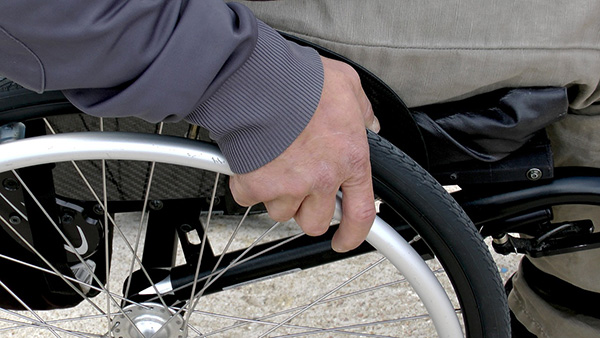
Why Non-Compliance is Inexcusable
Case in point: Benjamin Weiser at The New York Times points out that an incredible “83 percent of New York City’s public elementary schools are not ‘fully accessible’ to children with disabilities.” Citing an addition to one school, which was built in 2000, Weiser listed a number of problems, including “noncompliant door knobs, bathroom ‘grab bars’, drinking fountains, sinks and faucets.” The elevator didn’t meet the width requirements, nor were visual alarms installed in classrooms, as required by law.
The federal investigation into the non-compliance contained a disturbing description of how students and their families were impacted: “A parent of this elementary school child was forced to travel to the school multiple times a day, every school day, in order to carry her child up and down stairs to her classroom, to the cafeteria, and to other areas of the school in which classes and programs were held.”
With the exception perhaps of the elevator, many of the fixes in this example (door knobs, visual alarms, fountains, sinks and so on) would be relatively inexpensive to bring to code. Other things that wouldn’t cost much to install or implement include better lighting and signage, the use of bright colors for the visually impaired, and ensuring that displays in hallways or aisles don’t impede navigation, especially wheelchair users.
Accessibility is for Every Body
Facilities managers need to know exactly who will be using their buildings: Accessibility is not just for people using wheelchairs, but also for those who are blind or partially sighted, for people who are hearing impaired, for people who are chemically sensitive, and for people who are cognitively impaired.
The obesity epidemic has further created a large number of people with limited mobility, and as the world’s population ages interior environments in all private, commercial and public arenas will need to be made more accessible. Mobility issues may mean such assistive solutions will be required, from installing more moving sidewalks (usually only now seen at airports) or higher seating in restaurants, and more seating in mall and airport corridors.
Making Facilities Fully Accessible Takes Thoughtfulness
The diversity of true accessibility means elevators should not just be correctly sized to allow for wheelchairs and to allow for companion animals, but should have audio and visual cues. Similarly, accessible sidewalks should feature pavement textures to serve as markers for the blind who rely on canes. It can mean using a decorative feature like a fountain as a prompt for the hearing impaired (“turn left at the fountain”).
FMs should be familiar with how those with disabilities function; realizing, for instance, that blind people make use of directional memory, memorizing routes, so that unnecessary changes to pathways should be minimized.
Understanding Invisible Conditions
Many disabilities are non-apparent. Lori Golden, who leads Ernst & Young’s AccessAbilities initiative, defines non-visible disabilities in her article at DiversityInc as being “serious illnesses or chronic health conditions, sensory limitations, or mental health and learning disabilities.”
Some people are taking on disability access initiatives themselves. A 10-year-old in Scotland with Crohn’s disease (a painful bowel condition), actually launched a campaign to change the sign on accessible public bathrooms in reaction to how she was treated when perceived as an able-bodied person using the facility.
As reported in The Mighty, Grace Warnock designed the sign herself, which includes “a person in a wheelchair and a standing person with a heart, symbolizing people with invisible conditions.” The signs have been installed on three accessible bathrooms in the Scottish Parliament.
Even the colors you use in signage can have repercussions. Timothy Burke at Deadspin took Nike to task for uniforms that made watching an NFL game impossible for colorblind fans. While that specific incident can be viewed as not much more than an irritant, signs that people can’t see easily can be a real safety issue.
User interface designers at Google know about color blindness and incorporate solutions in their apps, such as using alternatives like labels or other visual cues, which is a practice FMs can easily put into place.
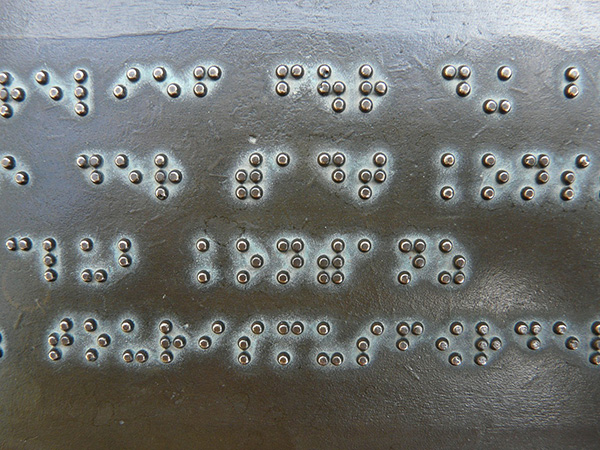
Good Examples of Accessible Buildings
Facilities manager looking for examples of building accessibility features to implement can take notes from the United Nations Accessibility Center. UN Secretary-General Ban Ki-moon writes that the complex features wheelchair-charging stations, Braille printers, hearing devices and a dedicated relief area for service dogs.
Another facility to look to is Edinboro University in Pennsylvania, which was highlighted in the October 2014 edition of Campus Safety Magazine as “going above and beyond ADA compliance.”
The director of the Offices for Students with Disabilities, Kim Kennedy, told the magazine that the school tries to incorporate inclusion in any renovation plan, creating facilities that work for everyone. “Our approach,” she explains, “is, and always has been, to view the ADA compliance standard as the minimum qualification when providing students access to classrooms, residence halls, and co-curricular and extracurricular activities.”
One such renovation at Edinboro University is an indoor bridge that connects campus buildings. It is wheelchair accessible and allows students to avoid steep hills as well as traffic, making it easier for everyone to get across campus.
Barrier-free accessibility is also a major initiative at Western University, near Toronto, and provides another good example of an accessible facility. From welcoming service animals to renovating older buildings on campus (the school was founded in 1878) to installing walkway enhancements in bright red and yellow for the visually impaired, Western budgets for barrier-removal initiatives and publishes its plans and accomplishments online.
What Should You Do First?
Unlike the building code, writes Joan W. Stein of FacilitiesNet, the ADA requires that “readily achievable barrier removal be performed on an ongoing basis.” And when you renovate or alter “primary function areas,” requirements for compliance are higher. Restrooms and paths of travel are spaces that require extra attention, with entrances and parking lots particularly important.
Heidi Schwartz at Facility Executive lists some of the 2010 ADA regulations that must be complied with in new construction and improvements. Those include such specifics as reach ranges (counter heights, for example) and increased turning and clearance space for wheelchairs in restrooms and workspaces. Any direct connections between parking garages and buildings must be accessible, and fitness centers and pools require clear floor space as well as accessible entries and exits.
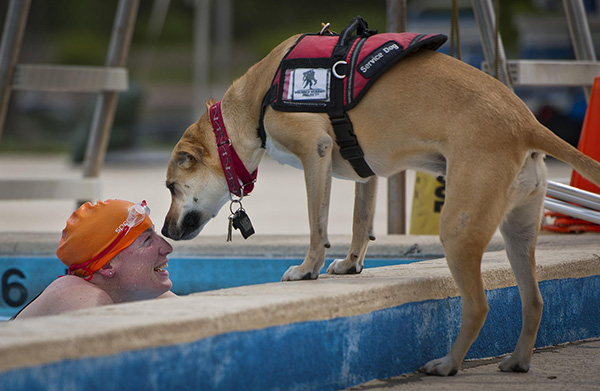
An Accessible World
It’s not just buildings that are being designed differently, retrofitted and scrutinized. Eva Recinos writes at PSFK that the U.S. Department of Transportation is currently exploring changes that could be made to airplanes to make them more accessible for people with disabilities. “Chief among these: accessible bathrooms on new single-aisle aircraft.”
In Jerusalem, terrorist attacks at city bus stops are being thwarted by the installation of safety barriers. However, reporter Renee Ghert-Zand of The Times of Israel writes that the government had to rethink the security design so the protected bus stops were accessible to everyone, including people using wheelchairs. The poles need to be spaced properly to allow wheelchair access on the ground as well as to ensure a passenger using a wheelchair can be lowered from or raised to the bus.
Accessible vacation spots, like beaches that loan out specialized beach wheelchairs and build boardwalks that go right to the water, are becoming increasingly available across the nation. Karen Wang at the Friendship Circle listed 32 vacation destinations for people with disabilities, including Morgan’s Wonderland, a theme park in San Antonio, which is the only one in the world where every single ride is accessible.
Credits:
Mike BraunHans Braxmeier
Sabine Genet
skeeze

